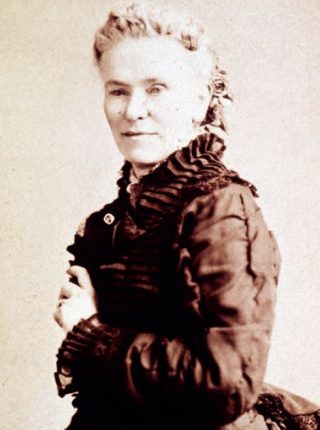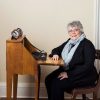Law and Altar: The Timely and Timeless Struggle of Matilda Joslyn Gage

WITH DEBATE IN THE U.S. Congress focused on the Equality Act—a bill seeking expansion of civil rights protections to the LGBTQ community in opposition to social services exclusions claimed by religious institutions—the struggle between church and state is back in the headlines. Opposition to the bill is frequently cast in terms of a conservative backlash to the Marriage Equality Act of 2015; however, attempts to destroy the wall between church and state date to the foundation of the United States. Between 1888 and the end of World War II alone, Congress saw 142 religious-based bills seeking to prioritize Christianity. Some of these attempts (Abbington School District vs. Schempp, Epperson vs. Arkansas) are touchstones of U.S. culture. Other equally important stories dealing with this foundational struggle are less well known.
As arguments over the separation of church and state once more shake the halls of Congress, what follows is one such story. Broadly, it involves how the threat to religious freedom created a rift between the most prominent figures in the women’s suffrage movement of the late 19th century, and how examining that obscured rupture reveals an inconvenient truth about the historical circumstances of women’s suffrage in the United States. Specifically, it is the story of Matilda Joslyn Gage, the political catastrophe she attempted to prevent and the moral ly compromised future resulting from society’s failure to heed her persistent warning that the ends do not always justify the means.
WHILE SUSAN B. ANTHONY AND Elizabeth Cady Stanton are today acknowledged as the heads of the National Woman Suffrage Association (NWSA), in the years between its 1869 founding and 1889 dissolution, Gage held an equal share of leadership. Arguably the most progressive of the three, Gage called for a woman’s right to control her own body and equal pay; exposed the sexual abuse of children and women by priests and the practice of sex trafficking; celebrated the superiority of Indigenous cultures and named Christianity as the source of women’s oppression.
These progressive stances played no small part in Gage’s erasure from the movement. When Anthony’s merger of NWSA and its rival, the American Woman Suffrage Association (AWSA), created the National American Woman Suffrage Association (NAWSA) in 1890, Gage departed the mainstream movement. NAWSA pivoted to a more conservative direction, dropping or downplaying all other feminist issues, including bodily rights and legislative reform, to focus on the right to vote. Naming it the death of the women’s rights movement, Gage explicitly feared the threat presented by Anthony’s alliance with the Women’s Christian Temperance Union (WCTU) and its “organized army of mother love for God, home and heaven.”
Anthony idolized the head of the WCTU, Frances Willard—an autocratic figure Gage deemed “the most dangerous woman in America.” While explicitly seeking to outlaw the use of alcohol and tobacco through a constitutional amendment, the WCTU had a far more insidious agenda. “The Women’s Christian Temperance Union, local, state, national, world-wide—has one vital organic thought, one absorbing purpose, one undying enthusiasm,” Willard proclaimed. “It is that Christ shall be this world’s King. King of its courts, its camps, and its commerce; King of its colleges and its cloisters; King of its customs and its constitutions.” Willard and the WCTU’s goal of embedding Christianity in the courts and constitution threatened the very foundation of religious liberty, Gage warned, and would “foreshadow the persecutions of the middle ages.” Invocations of the medieval period were not without merit, for it was in a visitation from God, Willard explained, that she had been instructed to secure the vote for women to inscribe God in the Constitution.
Where Gage saw potential catastrophe, however, Anthony saw a powerful ally. Together, the NWSA and the AWSA had only about 10,000 members. The WCTU possessed over 200,000—numbers that dazzled Anthony. Willard planned to field this organized army in a battle to enshrine God in the constitution and Jesus Christ as the head of government. This idea was abhorrent to Gage, but Anthony considered the loss of religious liberty a small price to pay for women gaining the vote.
Failing in her attempt to stop the 1890 merger that created NAWSA, Gage exited the suffrage movement. Later in 1890, she would re-emerge, however, drawing together progressives from around the country to start the Woman’s National Liberal Union (WNLU). Established to preserve the religious autonomy of our government, the aims of WNLU were clear from the start. “The encroachments of ‘The Christian Party in Politics,’ composed of both Catholics and Protestants, were never so great as at the present time,” Gage declared. “Therefore, in order to help preserve the very life of the republic, it is imperative that women should unite on a platform of opposition to the teachings and aim of that ever most unscrupulous enemy of freedom—the Church.”
With such bold pronouncements, Gage was confronting the whole of the conservative Christian establishment. In particular, her words directly opposed the prerogatives of its most globally recognized leader. Calling for the Third (U.S.) Plenary Council in 1884, Pope Leo XIII instructed “all Catholics to do all in their power to cause the constitution of the States and legislature to be modeled on the principles of the true church.” This frontal attack on democracy continued with, among other things, the 1888 papal encyclical, “On the Nature of Human Liberty,” which iterated: “ … all the arguments by which We disprove the principle of separation of Church and State are conclusive … [I]t is not of itself wrong to prefer a democratic form of government, if only the Catholic doctrine be maintained as to the origin and exercise of power.”
That Catholic doctrine of power extended to the home, where Pope Leo XIII asserted: “The husband is the chief of the family and the head of the wife. The woman, because she is flesh of his flesh, and bone of his bone, must be subject to her husband and obey him.”
This assault on the separation of church and state proved ecumenical, with Protestant initiatives reinforcing the efforts of Catholics. Among the most extreme segments of the Protestant wing attempting to dissolve the barrier between church and state was the National Reform Association. Formed in 1863 by 11 Protestant denominations, the constitution of the NRA explained:
“The object of this Society shall be to … secure such an amendment to the Constitution of the United States as will declare the nation’s allegiance to Jesus Christ and its acceptance of the moral laws of the Christian religion, and so indicate that this is a Christian nation, and place all the Christian laws, institutions and usages of our government on an undeniably legal basis in the fundamental law of the land.”
In but one example of their legislative attempts to merge church and state, the NRA trailed in the wake of another historic human rights movement of the late 19th century, labor rights, attempting to use the popular cause to smuggle its religious agenda into law. In 1888 Sen. Henry W. Blair (R-New Hampshire) introduced his Blair Sunday Rest bill into Congress. This bill, Blair promised, would “secure to the people the enjoyment of the first day of the week, commonly known as the Lord’s Day, as a day of rest.” It would also “promote its observance as a day of religious worship,” enforcing the biblical sanction to rest, as God did, on the seventh day. Likely to the horror, though not surprise, of Gage, this blatantly religious legislation quickly garnered over a million signatures of support from Willard’s WCTU.
The corrosive effect of such papal pronouncements and legislative efforts to women’s liberation were precisely what Gage had warned against when Anthony decided to merge with the WCTU. “Then you regard the Church as the chain upon the liberty of woman?” a Washington Critic reporter asked Gage. “I regard the Church as the basic principle of immorality in the world … and of injustice to women,” she replied. “There is no better proof … than the indisputable fact of woman’s subjection under them and the stinging rebukes she received from the Church at each and every step she has made toward natural freedom of body, mind and soul.”
Initially, Stanton agreed with Gage. “I would rather live under a government of men alone without religious liberty than under a mixed government without it,” she proclaimed. “If the Constitution can’t recognize women, whom it has seen, how can it be expected to recognize God, whom it has not seen?” Stanton quipped. Nevertheless, despite initially promising to join Gage’s WNLU, she did not. When Anthony dangled the presidency of the newly formed NAWSA in front of her, Stanton accepted and backed out on her commitment with Gage.
While insufficient funding dimmed, then extinguished, the WNLU’s promise to stem the tide of religious encroachment into the government, Gage continued these efforts through her writing. In 1893 she published “Woman, Church and State.” Considered her major work, it exposed both the Christian overthrow of superior Indigenous cultures and the embedding of woman’s inferiority into common law. She ends the book with these words: “During the ages, no rebellion has been of like importance with that of Woman against the tyranny of Church and State; none has had its far reaching effects. We note its beginning; its progress will overthrow every existing form of these institutions; its end will be a regenerated world.”
Despite the previous rift caused with her acceptance of Anthony’s offer to serve as president of NAWSA, Stanton eventually followed Gage’s path. Though the reunion was likely satisfying to Gage, it is unlikely to have come as a surprise Even before her split with Gage, Stanton had expressed doubts on the issue as early as 1885, stating that “as I have passed from the political to the religious phase of this question, I now see more clearly than ever, that the arch enemy to woman’s freedom skulks behind the altar.”
Countering centuries of male domination in the field of biblical exegesis, Stanton went on to form a committee of women, including Gage, to interpret the Bible. Stanton wrote in her edited “The Woman’s Bible:”
“The Pentateuch makes woman a mere after thought in creation; the author of evil; cursed in her maternity; a subject in marriage; and claims divine authority for this fourfold bondage, this wholesale desecration of the mothers of the race. I do not believe God ever wrote or inspired such sentiments.”
Now in the hands of Christian conservatives, such a courageous statement proved too much for the NAWSA. In a hotly debated move, Stanton was censured for her “Woman’s Bible,” making it perfectly clear that their former president in no way represented the organization in her views. Had the suffrage movement followed the path set by Gage and Stanton, what course might history have taken? How would Gage’s proposed world—one committed to separating religious dogma from governance while transforming religion from a source of oppression to a force for liberation—appear to us almost a century and half later?
Gage did not live to see her vision enacted. She was, however, adamant that such a world could exist. In the instant that those supporting her views evinced the courage not simply to consider her principles in theory, but to enact them in practice, she asserted that society would commence its transformation in earnest. “The moment has come,” she told a reporter in 1890, “for separating the chaff from the wheat and presenting true religion to the world—a religion which works for the good of humanity—a religion which recognizes and protects the rights of all.”



